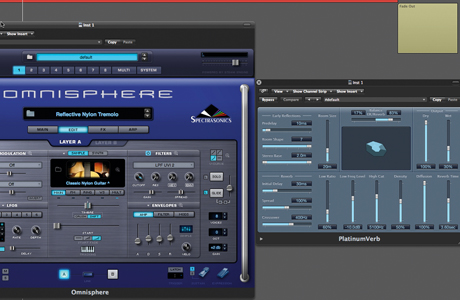Learning how to use tricks in the stereo field
Get creative and utilise the all the space stereo offers
The key to successful mixing is contrast. To hear loud things, you need to have heard quiet things and the relationships between far and near, dull and bright are also crucial, as is that between left and right.
This isn't only true in a 'music mix' context however and, in fact, some sound design sets out to achieve such extreme versions of these relationships that mixes start messing with your head. We've all heard moments where we've been tricked into thinking that a sound is behind is, or further left or right than our speakers are placed and it's huge fun to try to extend the stereo field so wide that you're pushing at the perceived limits of that width.
In the following walkthrough, we've created a music and sound design scene where a battle is happening behind a saloon bar. An armed guy is hiding in the bar and someone, similarly dangerous, comes looking for him. Having listened, import the final WAV into your DAW and complete it - you can decide who kills who in the inevitable shoot-out!

1. The first step is to provide a musical foundation upon which our sound effects will rest. We use Omnisphere and a program that combines ashimmering nylon guitar sound with a low pad. To this we add a 3.6-second reverb with a 67/33% dry/wet balance. Volume is kept low.

2.We import a 'battleground' fight scene, which is naturally bright. This is an 'outside' texture with low volume and the same reverb as the musicalbackground but with a lower High Cut Level. We use an EQ to roll off frequencies above 1.38kHz using a 12dB/octave slope. Volume is -22.5dB.

3. In our scene, either a hero or villain (you choose!) breaks from the fight to pursue a guy who's hiding in a saloon bar. We use footsteps on dirtto signal his approach 'around the outside' using volume, pan and a filter cutoff rise to signal the distance and direction of his approach.

4. As he arrives at the saloon door, he knocks hard. Against the distant, more muted sounds we've heard, a hard, loud, dry door knock, panned +40 (right), comes as a shock. After hearing nothing after his first knock, he knocks louder. Automate volume to make the second knock more purposeful.
Want all the hottest music and gear news, reviews, deals, features and more, direct to your inbox? Sign up here.

5. The response from the guy hiding inside is to load his gun, panned left to -50 to create a wide panorama. The knocking effect also causes afly to buzz, and we use the GRM Doppler effect on this sound to inject some side-to-side and front-to-back movement in the Centre of the mix.

6. We add a dry barn door open effect after the second knock and, to create a heightened sense of excitement, we add some fast breathing.This works well kept very dry and close to the listening position but needs to be panned as in Step 5, at -50 (left) to attribute it to the correct character.
Don't forget to listen to the audio examples at the top of the page.
Future Music is the number one magazine for today's producers. Packed with technique and technology we'll help you make great new music. All-access artist interviews, in-depth gear reviews, essential production tutorials and much more. Every marvellous monthly edition features reliable reviews of the latest and greatest hardware and software technology and techniques, unparalleled advice, in-depth interviews, sensational free samples and so much more to improve the experience and outcome of your music-making.
